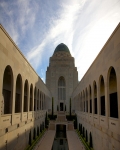Australian War Memorial
Archaeology »
Archaeological Monuments » Australian War Memorial
Australian War Memorial - Australia
Australian War Memorial is located in Canberra.
Australian War Memorial monument was established on 1941.
Primary threats to Australian War Memorial :
- The Australian War Memorial is Australia's national memorial.
- The memorial includes an extensive national military museum.
- Australian War Memorial because of the Parade's physical design leading up to the War Memorial.
Historical facts of Australian War Memorial :
- The Australian War Memorial is an iconic institution located in Canberra, the capital city of Australia. It serves as a national tribute to the men and women who have served in the country's armed forces and commemorates the sacrifices made during times of war. The memorial not only preserves and displays historical artifacts but also plays a crucial role in educating the public about Australia's military history. Let's delve into the historical facts surrounding the Australian War Memorial.
- The concept of establishing a war memorial in Australia can be traced back to the aftermath of World War I. In 1916, Charles Bean, an Australian war correspondent, proposed the idea of creating a memorial that would document the experiences of the Australian soldiers who fought in the war. Bean's vision was to build a comprehensive repository of records, artifacts, and personal stories to ensure that the sacrifices made by Australians would never be forgotten.
- The Australian War Memorial was officially opened on November 11, 1941, by the then Prime Minister, John Curtin. It was constructed on a site known as the Campbell Section, which had been selected due to its proximity to Parliament House. The memorial was designed by architects Emil Sodersten and John Crust in a classical architectural style, with influences from both Greek and Egyptian architecture. The main structure consists of a Byzantine-inspired dome, which stands as a symbol of remembrance and honor.
- One of the most significant features of the Australian War Memorial is the Hall of Memory. Located beneath the dome, this solemn space contains the Tomb of the Unknown Australian Soldier. The tomb represents all the unidentified soldiers who have lost their lives in war. It was interred on April 25, 1993, coinciding with the 75th anniversary of the landing at Gallipoli during World War I. The inscription on the tomb reads, "He is all of them and he is one of us."
- The memorial also houses a vast collection of artifacts, artworks, and historical documents related to Australia's military history. These include weapons, uniforms, medals, photographs, diaries, and letters. The collection is continually expanding through acquisitions, donations, and bequests, ensuring that the stories and experiences of Australian servicemen and women are preserved for future generations.
- Apart from its role as a repository of history, the Australian War Memorial also serves as a venue for commemorative events and ceremonies. Anzac Day, which is observed on April 25th each year, is one of the most significant occasions. It marks the anniversary of the first major military action fought by Australian and New Zealand forces during World War I. Thousands of people gather at the memorial on this day to pay their respects to the fallen soldiers.
- In recent years, the Australian War Memorial has undergone significant redevelopment and expansion. In 2018, plans were announced to enhance the memorial's facilities and create new exhibition spaces. This redevelopment aims to ensure that the memorial continues to engage and educate visitors, telling the stories of Australia's military history in a dynamic and immersive way.
- The Australian War Memorial stands as a testament to the courage, sacrifice, and resilience of the Australian armed forces. It is a place of remembrance, reflection, and education, preserving the memory of those who have served their country. Through its exhibitions, ceremonies, and ongoing research, the memorial honors the legacy of Australia's military history and ensures that the stories of the past are never forgotten.

